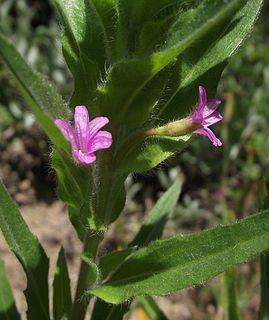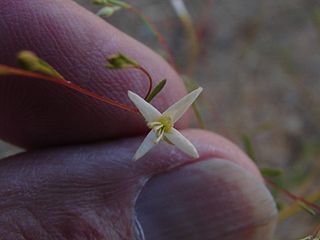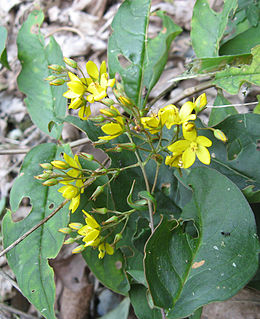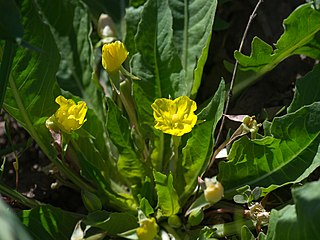
Epilobium densiflorum is a species of willowherb known by the common names denseflower willowherb, dense spike-primrose or dense boisduvalia. It is native to western North America from British Columbia to Baja California, where it is found in a variety of habitats. This is an erect annual often exceeding a meter in height with fuzzy green foliage. The pointed leaves are up to 8 centimeters long near the base of the plant, and the upper leaves are generally more hairy than the lower. The stem may branch or not. The top of the stem is occupied by a hairy, leafy, densely flowered inflorescence. Each flower has four deeply notched petals in shades of pinkish purple to nearly white with dark veining, each about a centimeter long. The fruit is a cylindrical capsule about a centimeter long.

Erysimum cheiri syn. Cheiranthus cheiri, the wallflower, is a species of flowering plant in the family Brassicaceae (Cruciferae), native to Europe but widespread as an introduced species elsewhere. It is also widely cultivated as a garden plant.

Gayophytum diffusum is a species of flowering plant in the evening primrose family known by the common name spreading groundsmoke. It is native to western North America where it is a common member of many different habitats. This is a spindly, branching annual herb reaching a maximum height of about half a meter. Its thin stems have sparse narrow leaves a few centimeters long. The occasional flowers are petite and usually white in color. The fruit is a cylindrical, knobby capsule up to 1.5 centimeters long.
Gayophytum humile is a species of flowering plant in the evening primrose family known by the common name dwarf groundsmoke. It is native to western North America from Alberta to California, and can also be found in parts of South America. It lives in many types of mountain habitats, especially moist areas. It is a small, thin annual herb not exceeding 30 centimeters in height. Its erect stem has few branches and sparse narrow leaves. The stem and leaves are green to bright red, or green with reddish edges and tips. The plant produces tiny white flowers each about half a centimeter across. The fruit is a capsule one to one and a half centimeters long containing up to 50 seeds.

Camissoniopsis bistorta is a species of flowering plant in the evening primrose family known by the common names southern suncup and California suncup. It is native to southern California and Baja California, where it grows in several types of plant community along the coast and in the coastal hills and mountain ranges. This is a hairy annual or perennial herb spreading from a basal rosette with stems reaching up to 80 centimeters long. Leaves are lance-shaped to narrowly arrowhead-shaped and sometimes toothed, and 1 to 12 centimeters in length. Toward the end of the spreading stems are nodding inflorescences of flowers, each flower with four bright yellow petals dotted with red at their bases. At the center are stamens and a protruding, nearly spherical stigma. The fruit is a straight or slightly coiled capsule up to 4 centimeters long.

Lysimachia fraseri is a rare species of flowering plant in the primrose family known by the common name Fraser's yellow loosestrife. It is native to the Southeastern United States, where it is listed as an endangered species in several states.
Camissonia contorta is a species of evening primrose known by the common name plains evening primrose. It is native to western North America from British Columbia to California to Idaho, where it grows in many habitat types. It is an annual herb producing a slender, bending to curling red or green stem which is sometimes hairy. It is up to 30 centimeters long and erect or spreading out. The blue-green leaves are linear to very narrowly oval in shape and up to 3.5 centimeters long. The nodding inflorescence produces one or more small flowers. Each has bright yellow petals up to half a centimeter long, sometimes with small red dots near the bases. The fruit is a capsule about 3 centimeters long containing shiny seeds.
Tetrapteron graciliflorum is a species of evening primrose known by the common name hill suncup. It is native to Oregon and California, where it grows in several habitat types, often on clay soils. It is an annual herb generally with no stem but producing an upright, nodding inflorescence. There is a cluster of narrow leaves each one to ten centimeters long. The flowers have bright yellow petals one half to two centimeters long. The fruit is a leathery capsule less than a centimeter in length with four chambers containing bumpy brown seeds.
Camissoniopsis hardhamiae is a species of evening primrose known by the common name Hardham's evening primrose. It is endemic to California, where it grows in the chaparral and woodland of San Luis Obispo and Monterey Counties. It is a robust annual herb producing a hairy stem up to about half a meter tall. The leaves are lance-shaped to narrowly oval and up to 12 centimeters long. The nodding inflorescence bears flowers with yellow petals each a few millimeters long. The fruit is a cylindrical capsule up to 2.5 centimeters long containing several dark-colored seeds.
Tetrapteron palmeri is a species of evening primrose known by the common name Palmer evening primrose. It is native to the western United States from California to Idaho, where it grows in several habitat types, including desert and sagebrush. It is a roughly hairy annual herb growing in a low patch on the ground, generally with no stem. The leaves are widely lance-shaped and up to about 5 centimeters long, with a few small teeth along the edges. The nodding inflorescence produces flowers with yellow petals only 2 or 3 millimeters long each and a noticeable bulbous stigma tip which may be up to a centimeter wide. The fruit is a leathery capsule around half a centimeter long with small wings near the tip.

Taraxia subacaulis is a species of evening primrose known by the common name diffuseflower evening primrose. It is native to the western United States, where it grows in several habitat types, especially in mountainous areas. It is a fleshy perennial herb growing from a taproot and usually lacking a stem. The leaves are lance-shaped to oval and up to 22 centimeters long and are borne on long petioles. The flower has yellow petals, each up to 1.5 centimeters long, and a large, bulbous stigma tip. The fruit is a leathery capsule 1 to 3 centimeters long.

Clarkia arcuata is a species of flowering plant in the evening primrose family known by the common name glandular clarkia. It is endemic to California, where it grows in the chaparral and woodlands of the foothills of the Sierra Nevada and southern Cascade Range. It is an annual herb producing a slender, erect stem often exceeding half a meter in height. The leaves are narrow, usually linear or lance-shaped, and up to 6 centimeters long. The inflorescence bears a few flowers, which dangle when they are buds and grow erect as they open. The sepals stay fused as the petals open and emerge from one side. They are coated in glandular hairs. The petals are up to 3 centimeters long, pink-lavender in color, sometimes with a reddish blotch at the base. They form a bowl-shaped corolla. There are 8 stamens and a protruding, four-chambered ovary. The fruit is an elongated capsule which may reach 3.5 centimeters long.

Clarkia exilis is a small herbaceous annual plant of western North America. It is an uncommon species in the evening primrose family known by the common names Kern River clarkia and slender clarkia.

Taraxia tanacetifolia is a species of evening primrose known by the common name tansyleaf evening primrose. It is native to the western United States, particularly the Great Basin and the mountains of the Pacific Northwest. It is a perennial herb growing from a woody taproot and spreading via lateral shoots. It lacks a stem and takes the form of a flat rosette of hairy leaves with a central inflorescence. The frilly leaves are long and narrow, lined with deep, irregular, narrow lobes. The leaf blades are up to about 30 centimeters long and are borne on long petioles. The flowers at the center of the rosette have bright yellow petals up to about 2.3 centimeters long. The fruit is a swollen, leathery capsule containing two rows of seeds.
Epilobium halleanum is a species of flowering plant in the evening primrose family known by the common name glandular willowherb. It is native to parts of western North America from British Columbia to New Mexico, where it grows in many types of habitat. It is an erect perennial herb growing up to about half a meter tall. The leaves are oval in shape low on the stem and narrower and somewhat lance-shaped higher, the longest about 4.5 centimeters long. The inflorescence is a raceme of glandular flowers, each with four notched white to pink petals a few millimeters long. The fruit is an elongated capsule up to 6 centimeters long.
Epilobium oregonense is a species of flowering plant in the evening primrose family known by the common name Oregon willowherb. It is native to western North America from British Columbia to Arizona, where it generally grows in moist places in several types of habitat. It is a perennial herb growing spindly erect stems approaching 40 centimeters high or sometimes forming mats spreading via stolons. The small leaves are rounded near the base of the plant and linear in shape farther up the stem. The inflorescence bears flowers with four white to pink petals each a few millimeters long. The fruit is an elongated capsule up to 5 centimeters in length which is borne on a long pedicel which may be longer than the capsule itself.
Epilobium torreyi is a species of flowering plant in the evening primrose family known by the common names Torrey's willowherb and brook spike-primrose. It is native to western North America from British Columbia to California, where it grows in many types of habitat, often in moist areas. It is a hairy annual herb producing a narrow, upright stem often exceeding half a meter tall lined with narrow lance-shaped leaves. The hairy, glandular inflorescence bears tiny white or pink flowers. They are usually cleistogamous, remaining closed and self-pollinating. The fruit is a capsule up to about a centimeter long.

Oenothera laciniata is a species of flowering plant in the evening primrose family known by the common name cutleaf evening primrose. It is native to the eastern United States but it can be found in many other places as an introduced species and sometimes a noxious weed. It is reported from Hawaii, Australia, Britain, France, Korea, Japan, and other areas. This is an annual or short-lived perennial herb producing a spreading stem from a hairy rosette of deeply cut or lobed leaves. Flowers occur in the axils of leaves higher on the stem. Each flower has pale to deep yellow petals up to about 2 centimeters long which fade orange, pink, or red with age. The fruit is a cylindrical capsule up to 5 centimeters in length.

Oenothera longissima is a species of flowering plant in the evening primrose family known by the common name longstem evening primrose. It is native to the southwestern United States, where it grows in relatively moist areas in scrub and woodland habitat. This is a biennial herb producing a tall, erect stem known to well exceed 2 meters in height. The widely lance-shaped leaves may be 22 centimeters in length and may have slight teeth along the edges. The inflorescence is a spike of showy large flowers. Each has yellow petals which may be more than 6 centimeters in length and fade orange or red with age. The fruit is a lance-shaped capsule up to 5.5 centimeters long.
Oenothera xylocarpa is a species of flowering plant in the evening primrose family known by the common name woodyfruit evening primrose. It is native to the Sierra Nevada of California, its range extending just into western Nevada. It grows in coniferous forest and meadow habitat, often in soils rich in pumice and other gravel. It is a perennial herb growing from a thick taproot and producing a flat, dense rosette of hairy, gray-green leaves. There is no stem. The showy flowers appear amidst the leaves. Each has four petals which may be nearly 4 centimeters long, bright yellow in color, fading pink to red with age. The fruit is a straight, curving, or twisting capsule which may be up to 9 centimeters long.










